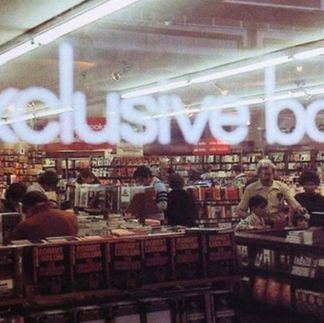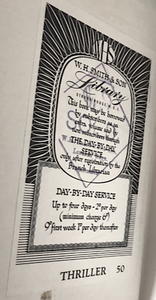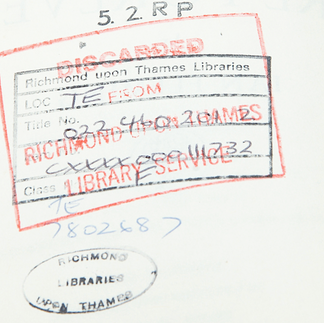Hidden gems that lie inside
- Peter Crush

- Apr 25, 2024
- 8 min read
There's a lot more than meets the eye to James Bond first editions. We look at some of the inside stamps and stickers that reveal hidden histories and intriguing backstories:

Today I’m going to say something that sellers of first editions seldom say.
There’s something not quite right about perfection.
Let me explain what I mean. Here at jamesbondfirsteditions.co.uk we rightly pride ourselves in presenting the finest condition Ian Fleming first editions there possibly are.
And yes, that means we hunt high and low to unearth as vivid, mint, and unblemished a book as is humanly possible.
However, as many collectors will also concur, what is a book without showing at least some evidence of its previous (and most likely interesting) ownership history?
For those that covet some previous ownership trail, some essence of a book's past is essential. That’s when a book has a story to tell; when it ceases to be a 'thing' you put on a pedestal, and when it becomes something that has had living, breathing history.
That’s why perfection – while often sought – is sometimes not always what often makes a book interesting.
That why as a collector of Ian Flemings books (as well as a dealer in them), I’m always on the look out for James Bond books that have demonstrably lived a life; those that can tell you something intriguing about where they might have come from, and who might have handled them in the past.
For anyone who owns a rare/collectable book is only the most recent custodian of it.
Your book may have changed hands many times before – and all of this means it has a history behind it.
So, in homage to all those Ian Fleming books that are not perfect, but have imperfections that make them perfect in another way, I’ve assembled a selection of Ian Fleming books that I either own, am selling, or have previously owned, that show signs of inner depth besides the novel contained within.
I hope you enjoy seeing and learning about what lies inside some of my existing/former Ian Fleming first editions:
The discrete bookseller’s label:
For many, the question that is most important about a book is: ‘where does it comes from’?
Maybe it had interesting former owner providence; or maybe it’s come from a far away land?
While the answer to these questions aren’t always easily known, one telltale addition can at least get the mind wandering – the bookseller’s sticker.
Often placed discretely on the inside board, a small sticker/stamp can say a lot.
From the old to the new - Exclusive Books (Johannesburg) - 1960s and the present day
Here’s one of interest (above) – of a copy of You Only Live Twice that I’ve recently acquired. Bookseller: Exclusive Books.
There’s a story here. Part of the history of James Bond books is that UK Cape editions of Ian Fleming titles were imported in large numbers by British overseas territories across the globe. As such, it is South Africa in particular, is where lots of examples ended up.
The bookseller in question here started life as a single secondhand book store, founded by Philip and Pamela Joseph, in Johannesburg in 1951. Today it has 42 bookstores in major cities in South Africa, making Exclusive Books one of the country's leading book retailers.
The Pretoria St, Hillbrow store – from which this Fleming title comes from – was first opened in 1954 and was only the second store to open. How many Fleming books passed through its tills, I wonder?
Today it is still going strong. Above is its more modern-looking present-day logo. And yes, James Bond books can still be bought there today (alas, only the current and newer reprints).
1 Trinity St - the UK's oldest continually inhabited bookshop: Bowes & Bowes then & now
Less far-flung, but no less interesting is Bowes & Bowes (1 Trinity Street, Cambridge) – and whose seller sticker adorns this first impression of Thunderball.
Its address is reputably one of the oldest continually inhabited bookshops in Britain, and the tradition of bookselling at this address dates back to at least 1581.
Bowes & Bowes’s history is intertwined with that of publishing and bookselling firm Macmillan & Co. When the business outgrew its Cambridge location, Alexander Macmillan opened up a branch in London in 1858. The Cambridge shop remained the firm’s headquarters until 1863, when Alexander officially moved the publishing business to London. Robert Bowes (nephew of Alexander), was left to manage the bookshop in Cambridge, which became known as Macmillan & Bowes in 1882. In 1899, Robert made his son, George Brimley Bowes, a partner at the shop, and the business officially became known as Bowes & Bowes in 1907.
The firm remained a family business until 1953, when W.H. Smith bought it. W.H. Smith continued to operate the shop under the name Bowes & Bowes until 1986, when it changed to Sherratt & Hughes, another subsidiary of W.H. Smith. In 1992, Cambridge University Press bought the premise and turned it into their primary bookstore, continuing the tradition of selling books at 1 Trinity Street.
Library and lending library plates
Boots:
UK pharmacy, Boots, has an indelible link to the history of Ian Fleming first editions.
Its network of high street stores saw develop the Boots Book-Lovers’ Library – a circulating library that ran from 1898-1966, until the passing of the Public Libraries and Museums Act 1964, which required councils to provide free public libraries.
In their prime, Boots lending libraries were established within branches of the chemist, and they even employed dedicated library staff whose training included examinations on both librarianship and literature.
Because they needed Ian Fleming books in advance of the official Jonathan Cape publishing date (mainly because they often also re-bound them in their own coloured boards), Boots were supplied the very earliest bound-up copies of each new Ian Fleming title. As such, there are collectors who specifically collect these Ian Fleming first edition variants (who also carried a 'Booklovers' [sic] shield on the front board).
Subscriptions were available in Classes A and B, the latter being restricted to borrowing books at least one year old, as well as a premium 'On Demand' subscription.
Above is a ‘Class A’ plate inside a first impression copy of You Only Live Twice.
WH Smith:
In a similar vein to Boots, high street stationery chain, WH Smith & Sons also ran a circulating library.
The WH Smith lending library started in 1860, and ran until 1961 (if fact, Boots actually took over this library). WH Smith also had a library department in its London head office.
Often, WH Smith libraries were installed in railway stations, enabling readers to borrow a WH Smith library book from a railway bookstall before boarding their train, and then return it to a different bookstall when they reached their destination.
The pictures next to the Boots library sticker above shows some typical WH Smith labels, with different daily and weekly lending charges.

By far the most unusual and interesting plates I’ve seen is this Man With The Golden Gun, (above) which appears to have lived a good part of its life in the library of the ‘Oxford Mechanics Institute’.
Mechanics’ Institutes date from around the 1820s onwards, and they existed as places of books in most large towns to educate the adult working-classes. In fact they were often funded by local industrialists – all hoping they would ultimately benefit from having more knowledgeable and skilled employees.
The first institute opened in 1823, in July Liverpool, followed by The London Mechanics' Institute (later Birkbeck College), in December 1823, and mechanics' institutes in Ipswich and Manchester (later to become UMIST), in 1824.
The movement gained momentum with the foundation in 1823 of The Mechanics’ Magazine by J C Robertson. By the mid-19th century, there were more than 700 institutes in towns and cities across the UK. Most contained libraries that were very small (only 19% of institutes had 1,000 books or more).
In 1835, only around 25% of members of the London Mechanics’ Institute came from what would now be regarded as the lower middle class – clerks, shopkeepers and other small businessmen – with the remainder being mainly skilled working men. Subscriptions were typically in the range of 10s (50p) to £1 per year for adults, and significantly less for youths, but this was often beyond the means of unskilled manual workers.
That said, the Oxford Mechanics’ Institute is credited with reducing the illiteracy rate in Oxford by 30% during 1839-70, with lectures in the building ranging from those given by science by university professors, on topics including the sciences of phrenology and mesmerism. Most mechanics institutes closed during the 1950-80s; some continue to be used as working men’s’ clubs.
Public libraries and other libraries
The vast majority of inner stamps will - of course - be those from public libraries, and there are as clearly many stamps as there are libraries.
Many Fleming titles entered the public library system straight away (ie first impressions), but by the time the later printings came out, an increasingly greater proportion found their way into public libraries. The middle and left pictures above show 6th and 7th impression examples of Diamonds Are Forever, from different libraries. The picture above and to the right is actually from a first impression of From Russia With Love.
Not all libraries are public libraries though, and occasionally, some genuinely intriguing internal stamps are revealed.
Above is the inside of a 4th impression of Casino Royale, which comes from the Scottish Command Library – the library of Army Headquarters, Scotland. Lending details go up to the late 1950s, and this book even includes its original library card and sleeve.

To the left is a plate from yet another, different, library - that of St Johns and Red Cross Hospital Library.
The first Red Cross War Library started in August 1914, and supplied books and papers to the Navy and Army. Donations of books came from the public and from publishers. They went to all of the hospital units treating the sick and wounded.
During the Second World War the Red Cross and St John Hospital Library Service provided books, magazines and illustrated papers for service patients in hospitals and convalescent homes at home and overseas. Almost all of these were gifts from the public.
The scheme was re-organised as a department of the Joint Committee of the Order of St John and British Red Cross in 1945 and continued its work within the National Health Service and with the armed forces.
The above example comes from a first edition, first impression of Casino Royale.

Stamps can tell you more
Sometimes, the name of the library is less interesting than the actual information a library stamp contains.
Above is an example of a library copy of Live and Let Die from Huntingdonshire.
The eagle-eyed amongst you might be able to spot one particularly interesting thing here: The book is dated 2nd April 1954 - which is actually three days earlier than this book's official publication date of 5th April.
Libraries often received the very earliest bound copies - in advance of the official publishing date - so they had time to add them to their catalogues, and (as often happened), rebind them.
This is a rare example of a book that is actually indelibly inked with a date prior to the official publication date.
And finally...
Who could fail to be enchanted by this Fleming first edition, stamped from half way across the world, in Calcutta (now Kolkata, the capital of India's West Bengal state) - see below.
The mind buzzes as to how this book ended up there in the first place (and now, how it's ended back in Britain again).
These are of course, just a small selection of what lies within that's out there waiting to be spotted. So, if you're looking at making your next Ian Fleming purchase, I implore you to not dismiss the 'imperfect' and take a moment to pause and see what else might be hidden inside...
































Comments